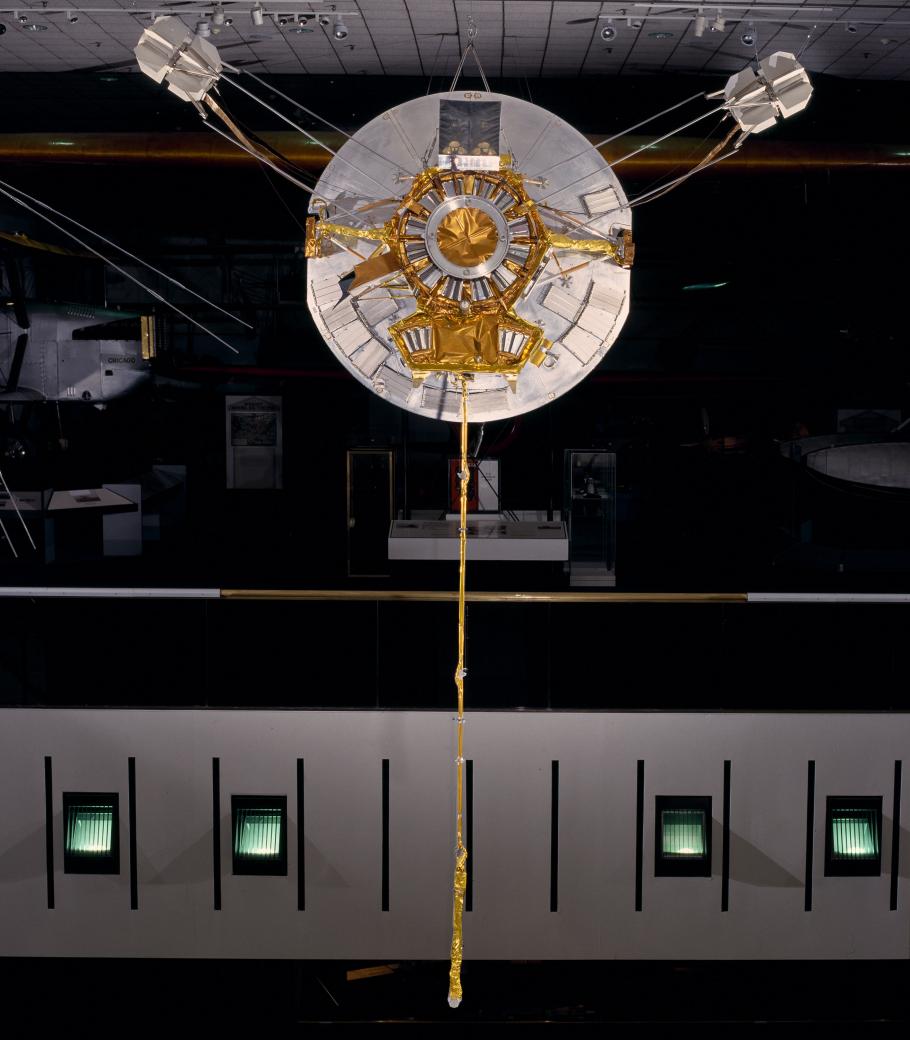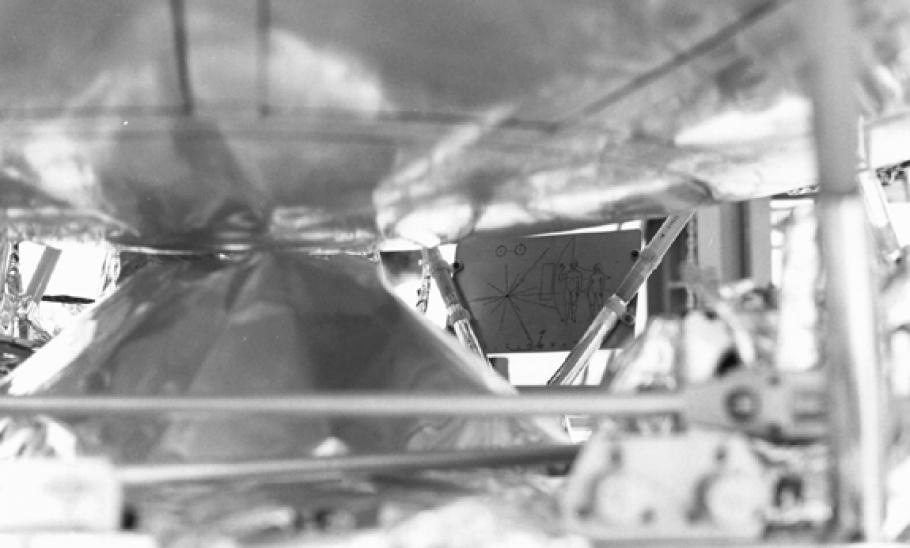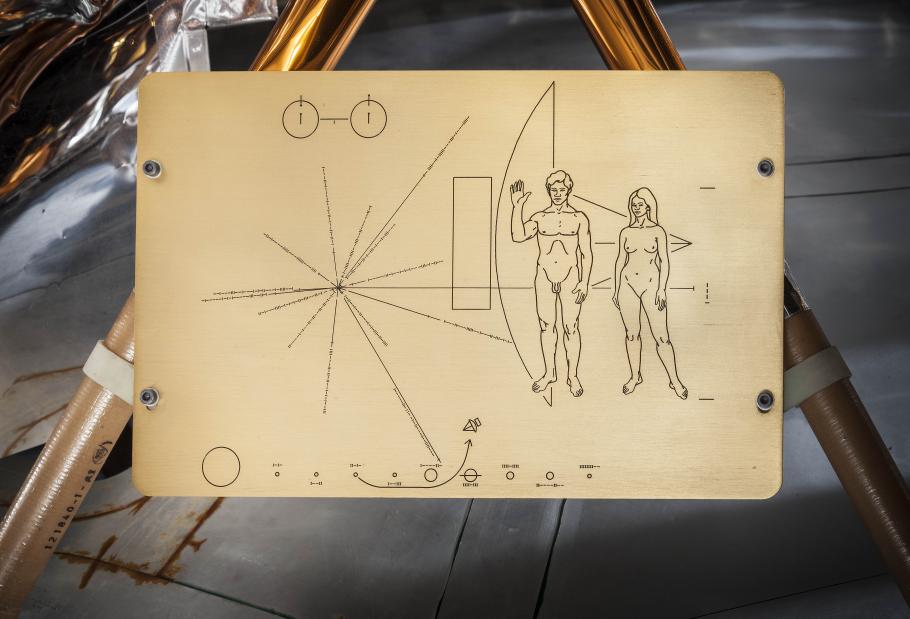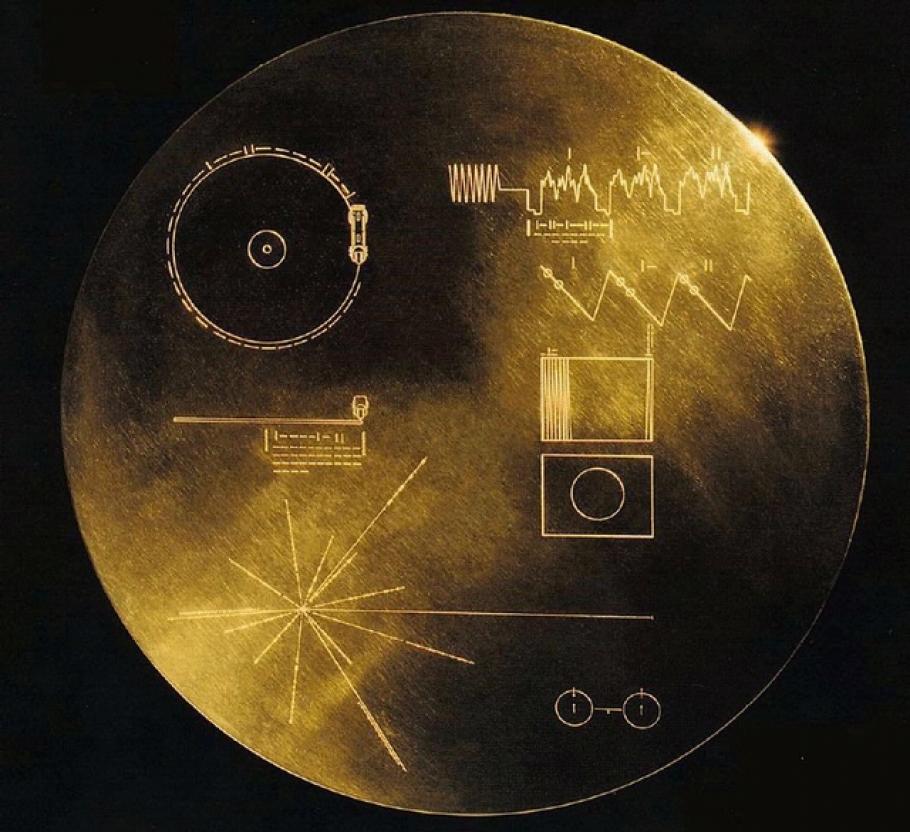The National Air and Space Museum's full-scale mockup of the Pioneer 10 spacecraft was recently moved to its new location in the Boeing Milestones of Flight Hall as a part of a major renovation to the gallery. The spacecraft includes power supplies, a large dish antenna, and several science instruments used during encounters with the outer planets of the solar system. It also contains something that might sound more like science fiction: A note to any alien civilization that might come across the spacecraft in the distant future.
A replica of the Pioneer 10 spacecraft on display in the Boeing Milestones of Flight Hall at the Museum in Washington, DC.
Pioneer 10 and 11 were the first spacecraft designed to visit the outer solar system—the region beyond Mars. Designed as identical spacecraft, Pioneer 10 was launched on March 2, 1972, and Pioneer 11 on April 6, 1973. Both traversed the asteroid belt and visited Jupiter, while Pioneer 11 also visited Saturn on its way out of the solar system. Pioneer 10 and 11 returned data until 2002 and 1995, respectively, until their power supplies became too weak to support operations. Pioneer 10 and 11, although no longer functioning, are leaving the solar system at 2.6 and 2.5 AU per year, respectively. One AU is the mean distance from the Earth to the Sun, or approximately 150 million km (93 million miles). During planning stages of the Pioneer 10 and 11 missions, science writer Eric Burgess suggested adding a greeting to an alien civilization. The mission team eventually decided to add a small plaque with the message. The plaques were designed by Carl Sagan and Frank Drake and drawn by Sagan's wife at the time, Linda Salzman Sagan. The gold-covered aluminum plaques were affixed to the antenna supports of the two spacecraft. They faced inward for protection from possible erosion caused by micrometeorite strikes. In the mockup on display in the Museum, the artwork faces outward. In Pioneer's new location in the Museum, visitors can get a view of the plaque from the balcony near the Albert Einstein Planetarium box office on the second floor. Look between the large dish antenna and the main part of the spacecraft closer to the wall. The rectangular plaque, about 23 x 15 centimeters (9 x 6 inches), can be seen behind the dish facing the floor away from the National Mall. You can also catch a glimpse standing on the first floor near the bottom of the escalators in front of the Museum store.
Deciphering the Pioneer Plaque The Pioneer plaque contains drawings of two humans and our place in the galaxy. The spacecraft is drawn behind a human male and female for scale. The solar system appears along the lower edge. Each planet and Pluto is shown with a binary number indicating the average distance from the Sun. Distances are listed in units of 1/10th the Mercury distance. The diagram in the upper left shows atomic hydrogen, by far the most abundant element in the universe. It shows a hydrogen atom undergoing a shift in its electron energy level. This change emits electromagnetic radiation at a wavelength of 21 centimeters (8 inches), and is the most common such emission in the universe. This is used as a frequency and distance scale represented by the binary number 1. Converging lines in the left show the position of the Sun relative to 14 pulsars in the Milky Way and the center of the galaxy. Pulsars are very dense remnants of exploded giant stars, and they rotate at very stable frequencies. The frequency of each pulsar is listed in binary numerals relative to the frequency of hydrogen emission. The average human height, of approximately 168 centimeters (or 5 feet 6 inches), is listed on the right-hand side as the binary number 8 (1000, shown as | - - - ), relative to the 21 centimeter (8 inch) wavelength of hydrogen emission. Leaving the Solar System Besides Pioneer 10 and 11, three other spacecraft have reached the Sun's escape velocity and are currently moving out into the stars: Voyager 1, Voyager 2, and New Horizons. The two Voyagers visited the gas giant planets of our solar system. A version of the Pioneer plaque also appears on a gold-covered phonograph record on each of the Voyager spacecraft. Although the Voyager spacecraft were launched five years after the Pioneers, they are traveling faster, and currently the Voyager 1 spacecraft is the most distant form the Earth. New Horizons just flew by Pluto and will continue through the Kuiper Belt. New Horizons contains several objects including a sample of the ashes of Clyde Tombaugh, the discoverer of Pluto. However, it does not carry any material intended to greet alien civilization.
It is very unlikely that the Pioneers or any of the other spacecraft will ever been seen by any alien civilization, even very far into future. Despite this, four of the outgoing spacecraft contain messages. We can see them more as messages to ourselves, not to aliens. They remind us that in the mid-20th Century A.D., human beings took the first steps toward exploring the universe.
| What message would you send to an alien civilization? Let us know. |




